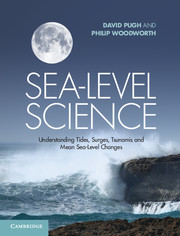Book contents
- Frontmatter
- Contents
- Preface
- List of acronyms
- List of main symbols
- Chapter 1 Introduction
- Chapter 2 Sea-level measuring systems
- Chapter 3 Tidal forces
- Chapter 4 Tidal analysis and prediction
- Chapter 5 Tidal dynamics
- Chapter 6 Shallow-water and coastal tides
- Chapter 7 Storm surges, meteotsunamis and other meteorological effects on sea level
- Chapter 8 Tsunamis
- Chapter 9 Spatial variations in sea level
- Chapter 10 Mean sea-level changes in time
- Chapter 11 Sea-level changes in time to do with the solid Earth
- Chapter 12 Sea-level applications
- Chapter 13 Sea level and life
- Appendix A Basic hydrostatic and hydrodynamic equations
- Appendix B Currents
- Appendix C High and low water times and heights from harmonic constituents
- Appendix D Theoretical tidal dynamics
- Appendix E Legal definitions in the coastal zone
- Glossary
- Index
- References
Chapter 11 - Sea-level changes in time to do with the solid Earth
Published online by Cambridge University Press: 05 May 2014
- Frontmatter
- Contents
- Preface
- List of acronyms
- List of main symbols
- Chapter 1 Introduction
- Chapter 2 Sea-level measuring systems
- Chapter 3 Tidal forces
- Chapter 4 Tidal analysis and prediction
- Chapter 5 Tidal dynamics
- Chapter 6 Shallow-water and coastal tides
- Chapter 7 Storm surges, meteotsunamis and other meteorological effects on sea level
- Chapter 8 Tsunamis
- Chapter 9 Spatial variations in sea level
- Chapter 10 Mean sea-level changes in time
- Chapter 11 Sea-level changes in time to do with the solid Earth
- Chapter 12 Sea-level applications
- Chapter 13 Sea level and life
- Appendix A Basic hydrostatic and hydrodynamic equations
- Appendix B Currents
- Appendix C High and low water times and heights from harmonic constituents
- Appendix D Theoretical tidal dynamics
- Appendix E Legal definitions in the coastal zone
- Glossary
- Index
- References
Summary
Whatever motion appears in the firmament arises not from any motion of the firmament, but from the earth’s motion.
Nicolaus Copernicus, The CommentariolusIntroduction
Mean sea level (MSL) records contain many examples of relative sea level being affected by geology as much as by the oceanography and climate discussed in the previous chapter. Figure 11.1 shows three examples; many more can be found in the scientific literature [1]. Unlike the sea-level rise experienced during the twentieth century at most locations around the world, the MSL record at Stockholm in Sweden shows a sea-level fall of approximately 4 mm/yr, which is a consequence of the land on which the tide gauge is situated experiencing a high rate of crustal uplift due to Glacial Isostatic Adjustment (GIA) [2, 3]. The record from Nezugaseki shows an example of a near-instantaneous change of MSL of about 20 cm due to the 1964 Niigata earthquake off the west coast of Japan [4]. Both of these examples are due to natural processes in the solid Earth. The third example is of a change in land level (and so relative sea level) due to an anthropogenic process, in this case groundwater pumping under Bangkok, Thailand [5]. Any analyst of MSL records will be aware of such large signals. However, the possibility of other, smaller and more subtle, signals in the data set cannot be excluded, and anyone who uses the records primarily for ocean or climate research must always be aware of them.
- Type
- Chapter
- Information
- Sea-Level ScienceUnderstanding Tides, Surges, Tsunamis and Mean Sea-Level Changes, pp. 296 - 317Publisher: Cambridge University PressPrint publication year: 2014



